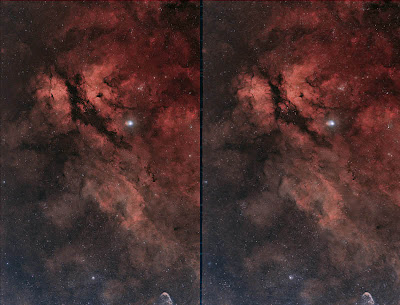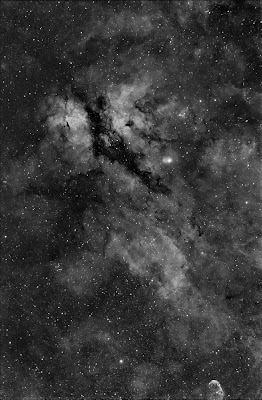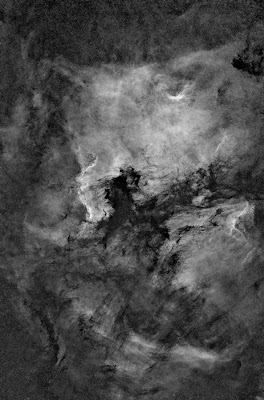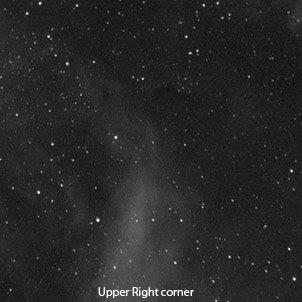COPYRIGHT, PLEASE NOTE
All the material on this website is copyrighted to J-P Metsavainio, if not otherwise stated. Any content on this website may not be reproduced without the author’s permission.
BUY A MUSEUM QUALITY POSTER
BUY A POSTER:https://astroanarchy.zenfolio.com/
Monday, September 29, 2008
Butterfly Nebula in narrowband colors
G(H-a)B(O-III)+ISO.jpg)
At last I was able to shot S-II channel for this image!
Last night was stormy and since I don't have a proper observatory, wind made
imaging really difficult. About half of the frames was shot trough speeding clouds.
In this image colors are showing difference between Double ionized Sulfur (Red),
Hydrogen alpha (Green) and triple ionized Oxygen (Blue).
This palette is generally known as a Hubble palette by the palette used to processing images
from Space telescope Hubble. Compared to my previous images, more details can be seen here.
-
Imaging data:
Camera, QHY8
Filters, Baader 7nm H-alpha and Baader 8,5nm O-III
Optics, Tokina AT-X 300mm @ f2.8
Camera, QHY8
Filters, Baader 7nm H-alpha and Baader 8,5nm O-III
Optics, Tokina AT-X 300mm @ f2.8
Exposures, 5 X 1200s H-alpha 3 X 1200s O-III
4 X 1200s S-II + flats and bias
-Guiding, LX200 GPS 12" + PHD-guiding and Lodestar
-
-
Just noticed, that there is a cosmic Seagull in the image!
It just reising its wings.
Butterfly in Narrowband Stereo
G(H-a)B(O-III)+PARALLEL+VISION.jpg) Parallel Vision image pair
Parallel Vision image pair G(H-a)B(O-III)+CROSS+VISION.jpg) Cross Vision image pair -
Cross Vision image pair -
For viewing istructions, please, look at the menu on the right hand side of the page.
Labels:
stereo images
Sunday, September 28, 2008
Butterfly Nebula, Colors of Autumn

I made some tests about colorbalance. I looked more closely
O-III channel and compared it to the H-alpha channel.
There was some large scale differences between those two.
This experiment is done to make those differences more visible.
Green channel is synthesized from O-III and H-alpha channels.
I think, this color scheme is very suitable for season up here.
Butterfly Nebula in 3D-stereo pair
First image pair is for "Parallel Vision" method.
Second one is for "Cross Vision" method.
Viewing instructions can be found here:
http://astroanarchy.blogspot.com/search/label/Stereo%20image%20viewing%20instructions


Labels:
stereo images
Saturday, September 27, 2008
Butterfly Nebula, second try

O-III = Blue. Green channel is Synthesized from Red and Blue.
-
Conditions were not too good last night, hard wind and clouds.
Guiding was really difficult doe the wind but PHD-guiding software does its best.
There was jus enough gaps between clouds, that I managed shot data for H-alpha
and O-III not enough though.
Actually part of the frames are shot trough not so thin clouds, maybe
H-alpha acts as a cloud filter : )
S-II data had to be left to the next time after the clouds rolled in.
Part of the NGC6888 the "Crescent Nebula" can be seen in the bottom of the image.
-
Imaging data:
-
Camera,
QHY8
-
Filters,
Baader 7nm H-alpha and Baader 8,5nm O-III
-
Optics,
Tokina AT-X 300mm @ f2.8
-
Exposures,
5 X 1200s H-alpha
3 X 1200 O-III
+ flats and bias
-
Guiding,
LX200 GPS 12" + PHD-guiding and Lodestar

H-alpha channel
Wednesday, September 24, 2008
Butterfly Nebula from bad night

Sometimes there is days (nights), when everything goes wrong.
Last night was one of them.
First I had problems with my laptop and I had to reboot it several times.
It's a old well served Dell and booting it up takes for ever.
Then one of the cord to telescope was damaged and it took about an hour to
figure it out. After that I was ready so start my narrowband imaging session with
three filters.
First I selected H-alpha filter and got everything ready for imaging.
Guider was working fine and I started recording. I went out and stepped on the main power cord. Total blackout to the telescope. Huh... After an hour I got all on and running again (reinstalling couple of drivers etc...)
There was no more time for all three bands anymore, so H-alpha was now my goal.
After 7 x 1200s (20 min.) exposure they all looked good.
BUT BUT... when I examined them more closely and extracted red pixels from RAW-images
(thats how it works with one shot clor camera), I notised DEW, all but firs image was contaminated by dew.
There is a heater for my filter drawer to prevent dewing and cord from the power unit
was damaged! I soldered it back together but there was not enough night left for anything.
I shot flat frames just to be sure, and went to sleep for two hours before work.
Image here is a one twenty minutes exposure!
Camera, QHY8
Filter, Baader 7nm H-alpha
Optics, Tokina AT-X 300mm f2.8
Exposure, 1 X 1200s + flats and bias
Guiding, LX200 GPS 12" + PHD-guiding and Lodestar
Labels:
Tokina 300mm f2.8 images
Wednesday, September 17, 2008
NGC7000 as a Stereo Pair image
-
Images are stereo vision image pairs.
They tell something about "true" nature of this object.
This is not a accurate presentation of the real 3D dimensions,
but gives an idea about real nature of three dimensional object
floating in three dimensional space.
-
If you need istructions, please, look at the menu right side of the page.
Labels:
stereo images
Monday, September 15, 2008
My first ever narrowband color image!

This is a very modest example of three colur narrowband image. But I place it here, since it's my first one. At 11.09. I mainly shoot H-alpha, but before clouds rolled in I managed to capture 4 x 900s O-III and only single shot of S-II, 900s. I will shoot more O-III and S-III when ever weather allows me to do so. In this image the "Hubble paletete" is used where S-II = Red, H-alpha = Green and O-III = Blue
-
NOTE
This image is taken by using QHY8 cooled 6.1mb color camera.
Its not an ideal tool for narrowband imaging.
Each color channel is shooted trough separate filter, this means,
that only 1/4 pixels are used for H-alpha and S-II.
O-III goes mainly to the Green and Blue
pixels of the Bayer matrix array, so about 3/4 of the pixels are used in this case.
How ever, very high quality narrowband images has been taken by using color cameras.
Sunday, September 14, 2008
11.09, the opening image of the season

This is a first light for my new equipment, Tokina AT-X 300mm f2.8 manual focus lens.
North America and Pelican nebula shooted @ f2.8 with Baader 7nm H-alpha filter.
I will shoot later S-II and O-III channels to this target (those two filters are new as well)
to create a false color narrowband image.
Even full open, this lens is very sharp and large diameter (112mm) combined to a
fast optics (f2.8) collects photons fast. Exposure time to this relatively deep image was
only 5 x 900s = 1h and 15min.
This fast lens has a very narrow critical focus zone, about 17microns. (17/1000mm !)
I updated my homemade focusing system for this lens to use it with FocusMax software.
Camera: QHY8 (Red pixels only)
Guiding: Lodestar guider and PHD-guiding with LX200 GPS 12"
Exposures: 5 x 900s with Baader 7nm H-alpha filter
Lens: Tokina AT-x 300mm @ f2.8


-
NO STARS
-
Here is a same image but all stars are removed.
This way more details are visible in nebula area
and total amount of nebulosity is revealed.
New equipmets and some development work.

System is based on temperature compensating TCF-s focuser and
it's very accurate.
I printed an angular scale and glued it to telescope ring.
The ring is supporting the front end of the heavy lens and same time works
as an indicator to a camera angle.
Labels:
equipments,
research and development
New flat "box" with EL-sheet.
I managed to buy one A2 size sheet of electro luminescent material.
(Here is the link: http://www.posterpoweruk.co.uk/page5.htm )
It works as a perfectly uniform light source and delivers perfect astronomical flats.
I used unexpencive, light weight, plastic frames to protect the light source.
(Not the one with real glas, it's too heavy for the purpose)
As seen in the image, I used two rubber bands with hooks to attach the panel.

In action
Labels:
equipments,
research and development
Angular scale for the AO-system
When OAG (Off Axis Guider) is used, the selection of the guidestar is very important.
Now it's relatively easy to put whole imaging system to an angle readed from
star chart.
The scale is printed to a sticker material and can be seen in upper image.
Labels:
research and development
New Lens for astro imaging


 Tokina AT-X 300 f2.8 is a big and heavy lens.
Tokina AT-X 300 f2.8 is a big and heavy lens.
Diameter of the main lens is 112mm.
Optical quality is very good. At f2.8 stars are absolute pinpoints to very corner of the
imaging area of my APS size camera.
STAR TEST IMAGES, LENS FULL OPEN @ f2.8:
Here is five images from cornes and the center of the image.
Image is just stacked (5 x 900s) and stretched, no other image processing methods are used.



Some brighter stars may have some distortion, but it's cauced by guiding and polar alignment errors.
-
-
 This is a single 900s H-alpha filtered, flat and bias calibrated frame.
This is a single 900s H-alpha filtered, flat and bias calibrated frame.Red pixels only, hence 1/4 size from original frame.
Mildly stretched under CCDStack software due the 8bit format, no other prcessing.
Labels:
equipments,
research and development
Subscribe to:
Posts (Atom)

















